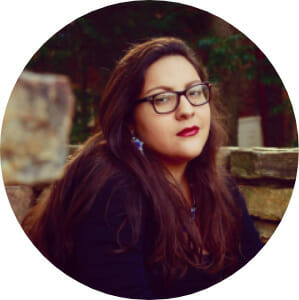About the artist

Taína Diaz-Reyes’ sound of belonging is the thunderous symphony of a monsoon in the Sonoran Desert. (7:55)
Taína Diaz-Reyes is an activist scholar working as a Senior Global Futures Scientist in the Julie Ann Wrigley Global Futures Laboratory® and PhD student in the School of Sustainability. She also serves as a communications and research consultant for the Sounds of Belonging project.
Audio transcript
I spent a long time debating whether to record the monsoon sounds, coyote howls on South Mountain, sirens, or the sounds of a Latino supermarket or Mercado Latino as my sound of belonging. I realized, however, that the coyote howls were a welcoming sound to the land and community, not necessarily a sound of belonging for me. The sounds of sirens are also not sounds of belonging, but instead, the sound of rejection. The constant presence of sirens in an urban setting displays the need of one group to control another, to exclude another, to display the wrongness of another, the need to discipline and correct the behaviors of another. It is the exact opposite of belonging. So, despite the familiarity of the sound, having grown up in cities most of my life, and admittedly, the odd comfort that the sound of sirens brings me, I decided that was not a sound of belonging. The sounds of a mercado, on the other hand, while important for my background and experience, I recognize are not as important to me as the smells of a mercado. The smell of Fabuloso after someone cleans an aisle, the smell of the fish and seafood section, the smell of the packaging of Mexican candies, the smell of decaying fruit in the produce section. It is the sense memory of smell that makes a mercado a significant place for me. So, I was going to record the simple sounds of me taking a desert hike somewhere here in the Phoenix Valley, and hope for a monsoon because it is monsoon season. I was fortunately blessed with a prolonged storm to record.
There are few things that bring me as much joy as rain in the desert. And this joy is amplified significantly by the presence of thunder and lightning. I was standing at the trailhead of the Gateway Trail at McDowell Sonoran Desert Preserve when the skies just opened up. I was soaked within seconds and could not be convinced to wipe the smile from my face. It would not have mattered what threat came at me. I was just so elated and excited. The skies had become a darker and darker grey as I drove to the preserve from Tempe where I live. I parked my car to have a quick meal before getting out to record the sounds. I was so pleased when the rain began to fall as I walked to the trail. There were squeals of delight from the hikers making their way back to their cars and a handful of people waiting at the trailhead for anyone who had fallen behind making their way out of the park.
I have loved monsoons since I was very young, standing in the driveway of my grandmother’s casita in Tucson. Which is the place where I first learned the smell of rain in the desert—where I first learned the sounds of the monsoon. The smell of creosote in the air, the smell of wet dirt, and the sight of wet pebbles in her yard. Watching the trees become a dark tear-streaked shade of brown as the water fell and ran down the bark. The booming of the thunder overhead as it came closer and closer from the distance. The phenomenal lightning shows—just the flashes of lightning—to accompany the symphony overhead. I loved the sound because of how loud it was and how disruptive it was. But more importantly for me, it signaled that something very exciting was about to happen. The downpour was coming, and I needed to be outside to experience it.
I think one of the other reasons why I love the monsoons is because people don’t expect something so intense and wet in the arid, Sonoran Desert. Whenever I tell people that Arizona has a monsoon season in the last month or two of summer, they just look at me surprised and ask. “Really?” The fact that the monsoon is seemingly antithetical to the realities of living in the desert is part of why the sound of the crackle of thunder and the sudden sheets of rain, the sound of rushing flood waters through the streets, excites me so much and makes me feel so at home.
I feel as though the monsoon is an excellent representation of who I am as a person. It’s just a jumble—a cacophony—of contradictions. But also, a tremendous display of power—no matter how dry the world seems, a life-giving and or deadly flood can overtake the land in seconds. But it’s even more important to me as a sound of belonging, because that is how I know I’m home. I would typically visit my family that lived here in Arizona during the summers, so the monsoon is essentially a welcome home. I was born under the storm day Kawak in the Mayan daily calendar. That discovery was so meaningful to me that I got the glyph for Kawak storm or rain on my ankle a few months ago.
The monsoon is not just an annual event, but a beckoning and a reminder of where I belong and who my people are. The land, the skies, the elements, the weather and my family here in this dry place—well, dry until the monsoon.